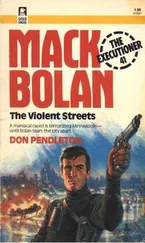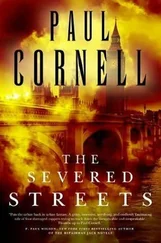Arriving back at the homicide office, the two men find that McLarney has already dispensed with the preliminaries. The paperwork has been given a start and the two billies who found the body are asleep in the fishbowl, their statements completed. And the woman that Brown talked with at the scene has called back; she’s heard a description of the victim on the neighborhood grapevine and it matches her aunt. Brown asks about the aunt’s jewelry and the woman describes both the necklace and earrings. He explains that there’s no need for the family to visit Penn Street for a positive identification; the facial injuries make that impossible. An hour or so later, fingerprint comparisons identify the dead woman as Carol Ann Wright, a young-looking forty-three-year-old who lived not two blocks from where she died. She was the mother of five children, and the last time her family saw her was a little before 11:00 P.M. on Saturday, when she walked over to Hanover Street to hitch a ride to the Southern District, where a friend of hers had been locked up.
By early afternoon, Brown has confirmed that his victim did indeed pay a brief visit to a prisoner at the Southern District holding cells before leaving for parts unknown. And by late afternoon the family is calling back with the rest of the story. True to Brown’s most fervent hopes, the good country folk of South Baltimore are talking to one another and to the police, spewing out any and all relevant facts and rumors.
Tracking the tale backward, Brown learns that a short time after the television stations began identifying the victim, the dead woman’s niece got a call from some friends over at Helen’s Hollywood Bar, down on Broadway in Fell’s Point. The bartendress and the manager both knew Carol, and both remember that she showed up close to 1:00 A.M. with some guy named Rick, who had long, dirty blond hair and drove a black sports car.
A short time later, the family calls again with more information: Before going to the bar that night, Carol went to a friend’s house over in Pigtown a little after midnight, looking to buy a little marijuana. Brown and Worden roll back out of the headquarters’ garage and drive first to South Stricker Street, where the friend confirms the visit but says she didn’t get a good look at the guy who drove Carol because he stayed in the car. She thinks he was young and kind of greasy looking, with longish blond hair. His car, she says, was blue or green. Maybe like a bluish green. Definitely not black.
Later that night, at Helen’s on Broadway, the two detectives get little more from the regular patrons and night employees. The guy had blond hair, kind of long and stringy, but with a little curl to it. And a mustache, too. Kind of thin.
“How tall?” Brown asks the bartendress. “My height?”
“No,” she says. “Shorter.”
“About his height?” he says, pointing to a customer.
“Maybe a little shorter than that.”
“What about the car?”
The car. Nothing is more frustrating for Brown and Worden than to listen to these people try to describe the automobile that ran over Carol Ann Wright. The woman on Stricker Street says it was a blue or green compact. The manager of the bar says it was black and sporty, with a T-top and a round insignia on the front of the hood, like a 280Z. No, says the bartendress, it had those doors that open upward, like wings.
“Winged doors?” says Brown, incredulous. “Like a Lotus?”
“I don’t know what you call it.”
“Are you sure?”
“I think so.”
It’s hard to dismiss the employee because she actually went outside at closing time and listened to this guy talk about how he’s a mechanic, a transmission expert, and does his own work on the car.
“He was real proud of it,” she tells Brown.
But it’s harder to believe her when she says that some greasy motor-head named Rick is running around South Baltimore in a custom $60,000 Lotus, giving billy girls a ride down to the Southern District. Yeah, right, thinks Brown, and Donald Worden is my personal love slave.
What’s especially aggravating to the detectives is that if these witnesses can’t get the car right-the car being a definite object with its make and model number displayed in chrome on its exterior-then they sure as hell can’t be trusted to come anywhere close on the guy’s description. Everyone mentions the shoulder-length blond hair, but some are saying stringy and others, curly. Only half of them have the thin mustache, and they’re all over the map on the guy’s height and weight. Eye color? Forget it. Distinctive features? Oh yeah, he was driving a Lotus.
Ordinarily, a bad description is par for the course. Any good detective or prosecutor knows that stranger-to-stranger identification is the weakest kind of evidence; in a crowded world, people just don’t have the facility to commit a new face to memory. Many veteran detectives don’t bother to include preliminary descriptions in their reports for that reason: A description of a six-foot-two, 220-pound suspect will hurt you in court when the guy turns out to be five-seven and 150. True to the stereotype, law enforcement studies have also shown that interracial identifications-blacks of whites, whites of blacks-tend to be the weakest because at first glance, both races have trouble distinguishing between members of the other. In Baltimore, at least, the reputation for the most ineffectual identifications goes to the Koreans, who run every other corner store in the inner city. “All rook arike” is the only credo they ever offer to a robbery detective.
But this case should have been different. For one thing, the identification is white-on-white. For another, the guy was in the bar for over an hour, hovering around Carol, making conversation with the other patrons and employees. Collectively, these people remember that the guy claimed to be a mechanic, a transmission expert actually, that he drank Budweiser, that he mentioned that a particular bar up in Parkville was for sale and that his uncle owned some bar in Highlandtown with a German-sounding name that no one can recall. They even remember that the guy got mad when Carol got up to dance to the jukebox with another girl. All of that has been committed to memory by the regulars at Helen’s, and yet Brown is left with nothing better than a partial description.
Frustrated, Brown works the bartendress through her story a second time, then communes with Worden at the back of the tavern, near the pool table.
“These are our best witnesses?” says Brown. “We don’t have dick.”
Leaning against the pay phone on the back wall, Worden gives Brown a what-you-mean-we-Kemosabe look.
“The problem is that it was closing time and they were all shitfaced,” Brown continues. “They’re not going to remember this guy well enough for a composite.”
Worden says nothing.
“You don’t think there’s any point in calling an artist, right?”
Worden looks at him skeptically. Even with good eyewitnesses, the composite sketches never manage to look like the suspect. Somehow, all the black guys resemble Eddie Brown and, depending on hair color, all the white guys are dead ringers for either Dunnigan or Landsman.
Brown persists. “There’s not enough here for a composite, right?”
Worden holds out his hand. “Gimme a quarter.”
Brown fishes up a twenty-five-cent piece, presuming that Worden wants to use the phone or maybe punch a song on the juke.
“Brown, you’re a piece of shit,” says Worden, pocketing the coin. “Finish your beer and let’s go.”
They are left with the worst kind of investigation, a needle-in-a-haystack search for blond-haired Rick and his black or maybe blue-green sports car. Reluctantly, Worden puts a description out on a teletype to the districts. He had hoped to keep that information from floating around too freely, because if word somehow gets back to the suspect that they have a partial description of the car, he’ll paint it or ditch it or hide it in a garage somewhere for about four months. The car, both detectives understand, is essential evidence.
Читать дальше












